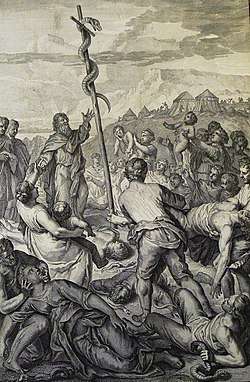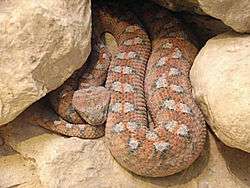Fiery flying serpent
The fiery flying serpent is a creature mentioned in the Book of Isaiah in the Hebrew Bible or in the Old Testament of the Christian Bible.

Name
The term "fiery flying serpent" is an English translation of the Hebrew words שרף מעופף, shārāp (a "fiery serpent") me‘ōpêp ("flying").[1]
Biblical accounts
Book of Isaiah
- Isaiah 14:29: "Do not rejoice, all you of Philistia, because the rod that struck you is broken; for out of the serpent's roots will come a viper, and its offspring will be a fiery flying serpent."[2]
- Isaiah 30:6: "The burden against the beasts of the South. Through a land of trouble and anguish, from which came the lioness and the lion, the viper and the fiery flying serpent, they will carry their riches on the backs of young donkeys, and their treasures on the humps of camels, to a people who shall not profit;"[3]
Other sources
References to "fiery serpents" lacking a mention of flight can be found in several places in the Hebrew Bible.
- Deuteronomy 8:15 "Who led thee through that great and terrible wilderness, wherein were fiery serpents, and scorpions, and drought, where there was no water; who brought thee forth water out of the rock of flint;"
- Numbers 21:6-8 "(6) And the LORD sent fiery serpents among the people, and they bit the people; and much people of Israel died. (7) Therefore the people came to Moses, and said, We have sinned, for we have spoken against the LORD, and against thee; pray unto the LORD, that he take away the serpents from us. And Moses prayed for the people. (8) And the LORD said unto Moses, Make thee a fiery serpent, and set it upon a pole: and it shall come to pass, that every one that is bitten, when he looketh upon it, shall live." This symbol, the Nehushtan, is similar to the ancient Greek Rod of Asklepios (frequently confused with the caduceus) and is frequently cited as an instance of the same archetype.
Book of Mormon
- The Book of Mormon: 1Nephi 17:41 "...he sent fiery flying serpents among them; and after they were bitten he prepared a way that they might be healed;"
Herodotus
In the History of Herodotus, Book 2, Herodotus describes flying winged serpents.
Cicero
In Cicero's On the Nature of the Gods Book 1 XXXVI, Cotta describes how the Egyptian ibis was deified because it "protects Egypt from plague, by killing and eating the flying serpents that are brought from the Libyan desert..."
Identification

Ronald Millett and John Pratt identify the fiery serpent with the Israeli saw-scale viper or carpet viper (Echis coloratus)[4][5] based on ten clues from the written sources: the serpents inhabit the Arava Valley, prefer rocky terrain, are deadly venomous,[6] extremely dangerous, have an especially painful "fiery" bite, reddish "fiery" color, lightning fast strike, leaping/"flying" strike, and cause death by internal bleeding.[7] A Roman account dated 22 AD about the deserts of Arabia indicates the presence of the saw-scale viper, reporting that "there are snakes also of a dark red color, a span in length, which spring up as high as a man's waist, and whose bite is incurable."[8] Other candidates include desert horned viper (and close relatives) and the desert black snake or black desert cobra.[9]
References
- Hebrew Text Analysis: Isaiah 14:29. Biblehub
- Isaiah 14:29. Multiple versions. Biblehub
- Isaiah 30:6. Multiple versions. Biblehub
- McDiarmid RW, Campbell JA, Touré T. 1999. Snake Species of the World: A Taxonomic and Geographic Reference, Volume 1. Washington, District of Columbia: Herpetologists' League. 511 pp. ISBN 1-893777-00-6 (series). ISBN 1-893777-01-4 (volume).
- J. N. Barnes, Serpents & Sand: The Snakes of Dhofar, - select "subjects" then "reptiles" and then "Serpents and sand" article. Entry for "carpet viper." "Carpet viper [saw-scale viper] (Echis carinatus, Echis coloratus, Echis pyramidum) - 76 cm. A very dangerous snake possessing one of the most toxic venoms of all land snakes. Found in rocky places or areas with vegetation around wadis and hillsides, sometimes in large numbers. Although rarely seen, carpet vipers can be aggressive and will strike after loudly rasping their scales together as a warning." apud Millett, Pratt 2000.
- Stanley S. Flower, "Notes on recent reptiles and amphibians of Egypt," Proceedings of the Zoological Society of London, 1933. Quote: "In modern times with the miracle of antivenin treatments and hospitalization in countries such as Israel, documented fatalities from Echis coloratus bites are rare. Most snakebite fatalities today occur in remote areas and the saw-scale viper is blamed for many thousands of deaths annually especially in Africa. The most relevant example to this study in the barren Arava valley area of the "fiery serpents" of a documented fatal echis coloratus bite is this account. Three British soldiers were bitten by the same echis coloratus snake in the Arava valley in 1918. All three soldiers died." apud Millett, Pratt 2000.
- Millett, Ronald P.; Pratt, John P. (9 June 2000). "What Fiery Flying Serpent Symbolized Christ?". Meridian Magazine. Illustrated by Randal Baker.
- Ancient History Sourcebook: Ancient Accounts of Arabia, 430 BCE - 550 CE. Strabo: Geography, c. 22 CE. XVI.iv.19.
- Alan E. Leviton, Steven C. Anderson, Kraig Adler, and Sherman A. Minton, Handbook to Middle East Amphibians and Reptiles, 1992, pp 110-114. Quote: "The snakes in the area are the Israeli saw-scale viper, Echis coloratus, desert horned viper and close relatives, Cerastes cerastes, Cerastes vipera, and Pseudocerastes persicus fieldi, and the desert black snake or black desert cobra, Walterinnesia aegyptia." apud Millett, Pratt 2000.